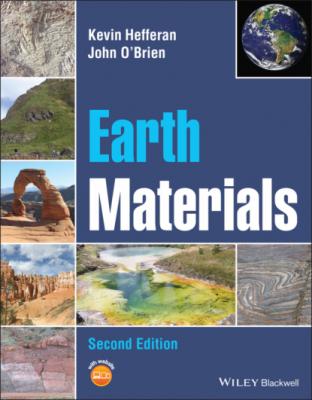Earth Materials. John O'Brien
Читать онлайн.| Название | Earth Materials |
|---|---|
| Автор произведения | John O'Brien |
| Жанр | География |
| Серия | |
| Издательство | География |
| Год выпуска | 0 |
| isbn | 9781119512219 |
3 Chapter 3Figure 3.1 Criteria for substitution are (a) similar size, (b) similar charg...Figure 3.2 Olivine complete substitution solid solution series.Figure 3.3 Compositions of carbonate minerals expressed in terms of the prop...Figure 3.4 Coupled ionic substitution in the plagioclase solid solution seri...Figure 3.5 Limited substitution and miscibility gap in calcium–magnesium car...Figure 3.6 Phase diagram for silica depicting the temperature–pressure stabi...Figure 3.7 Plagioclase phase stability diagram at atmospheric pressure, with...Figure 3.8 Diopside–anorthite phase diagram at atmospheric pressure.Figure 3.9 Albite–orthoclase phase diagram at atmospheric pressure.Figure 3.10 Phase diagram for the system nepheline–silica with the intermedi...Figure 3.11 Phase diagram for the system forsterite–silica with the intermed...Figure 3.12 Three types of radioactive decay: alpha decay, beta decay, and e...Figure 3.13 Progressive change in the proportions of radioactive parent (N) ...Figure 3.14 Uranium–lead concordia plot (blue) showing sample ages as a func...Figure 3.15 Rubidium–strontium systematics, showing evolution in the composi...
4 Chapter 4Figure 4.1 Representative mineral crystals: representative mineral crystals:...Figure 4.2 (a) Two‐dimensional translation at right angles (t1 and t2) to ge...Figure 4.3 Five major types of rotational symmetry operations, viewed lookin...Figure 4.4 Two‐ and three‐dimensional motifs that illustrate the concept of ...Figure 4.5 Inversion through a center of symmetry (i) illustrated by the let...Figure 4.6 (a) Mirror plane (m) with the translation vector (t), contrasted ...Figure 4.7 (a) An axis of fourfold rotation (4). This contrasts with (b) an ...Figure 4.8 The 10 plane point groups defined by rotational and reflection sy...Figure 4.9 The five principal types of meshes or nets and their unit meshes ...Figure 4.10 A primitive unit cell and a long‐range space point lattice that ...Figure 4.11 Relationship between (a) atomic packing, (b) a unit cell, and (c...Figure 4.12 The 14 Bravais lattices and the six (or seven) crystal systems t...Figure 4.13 Conventional labeling of crystallographic axes, illustrating the...Figure 4.14 Crystallographic axes (positive ends labeled) and intersection a...Figure 4.15 A pyritohedron, a closed form in which all faces have the same g...Figure 4.16 Different types of dipyramid forms in the trigonal, tetragonal, ...Figure 4.17 (a) Common open forms: pedions, pinacoids, domes, sphenoids, and...Figure 4.18 Representative crystal faces that cut one, two or three crystall...Figure 4.19 Unit face (outlined in solid blue) in an orthorhombic crystal wi...Figure 4.20 Faces with different Weiss parameters on an orthorhombic crystal...Figure 4.21 (a) The darkened front crystal face possesses the Weiss paramete...Figure 4.22 Miller indices of various crystal faces on a cube depend on thei...Figure 4.23 Isometric octahedron outlined in blue possesses eight faces; the...Figure 4.24 Five common forms in the isometric system: (a) cube, (b) octahed...Figure 4.25 Common crystal forms in the tetragonal crystal system: (a) tetra...Figure 4.26 Common crystal forms in the hexagonal crystal system (hexagonal ...Figure 4.27 Common crystal forms in the trigonal system: (a) trigonal dipyra...Figure 4.28 Common crystal forms in the orthorhombic crystal system: (a) rho...Figure 4.29 Monoclinic crystal forms: (a) front, side, and basal pinacoids, ...Figure 4.30 Triclinic crystal forms: (a) front, side, and basal pinacoids, (...Figure 4.31 Examples of twinned crystals: (a) swallowtail twins in gypsum; (...Figure B4.1 (a) Frenkel defect, with a vacancy due to an ion displaced to th...Figure 4.32 (a) Perfect crystal lattice; (b) substitution defect; (c) inters...Figure 4.33 (a) Edge dislocation with an extra half plane of atoms; this is ...Figure 4.34 Two‐dimensional depiction of how an edge dislocation created by ...Figure 4.35 Three types of planar defect (shown in two dimensions): (a) inte...Figure B4.2 (a) Deformation map showing the significant role of omission def...Figure 4.36 Phase stability diagram showing the conditions under which graph...Figure 4.37 The closely similar structures of α‐ and β‐quartz.Figure 4.38 Variations in the order of minerals.Figure 4.39 (a) Hematite replacing pyrite; (b) chalcedony encrusting aragoni...
5 Chapter 5Figure 5.1 Individual crystal habits: A. equant, B. tabular, C. platy, D. pr...Figure 5.2 Crystal aggregate habits, clockwise from upper left: top row: fib...Figure 5.3 Crystal aggregate habits (left to right); top row: massive kaolin...Figure 5.4 Crystals with various percentages of bounding
